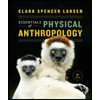Textbook to be utilized as the ONLY reference: Mirror for Humanity: A Concise Introduction to Cultural Anthropology
11th Edition, 2018 ISBN (U.S.): 9781259818424
Refer to chapters 1-3 in the textbook, then choose ONE of these three topics, and develop your answer in approximately 500 effective words (10% +/-) Essay style, including an introduction and a conclusion. Include page numbers in in-text citations.
Examine anthropology’s dual identity as a member of both the social sciences and the humanities. What advantages and problems do you see rooted in this dual identity?
Describe the process of enculturation to a subculture with which you are familiar or have observed (such as a professional subculture in the workplace).
Analyze the role of ethics and values in conducting anthropological research abroad (beyond one’s own society).
Refer to chapters 4-6 in the textbook, then choose ONE of these three topics, and develop your answer in approximately 500 effective words (10% +/-) Essay style, including an introduction and a conclusion. Include page numbers in in-text citations.
Analyze how socioeconomic, ethnic, and gender differences are reflected in language. Give specific examples.
Define adaptive strategy. Identify the five adaptive strategies in Cohen’s typology of societies. Discuss how Cohen links economy and social features.
Outline the defining features of states and explain how the primary specialized units of states interact.
Refer to chapters 7-10 in the textbook, then choose ONE of these three topics, and develop your answer in approximately 500 effective words (10% +/-) Essay style, including an introduction and a conclusion. Include page numbers in in-text citations.
Analyze the relationship between gender and socioeconomic class in industrialized societies. Do gender roles, gender stratification, men’s and women’s participation in the public and private spheres, and/or their ability to acquire and control important resources vary between socioeconomic classes? What are some of the reasons that such differences may exist?
Define rite of passage. Identify three phases that ordinarily constitute a rite of passage. Provide at least two different examples to illustrate your answer.
Distinguish between ethnicity and “race.” What does it mean to say that “race” is a social construction?
Refer to chapters 11-13 in the textbook, then choose ONE of these three topics, and develop your answer in approximately 500 effective words (10% +/-) Essay style, including an introduction and a conclusion. Include page numbers in in-text citations.
Describe the overlapping histories of “applied” and “academic” anthropology that Kottak identifies in chapter 11 (e.g., in Malinowski’s work on land tenure during British colonialism). What ethical dilemmas, as well as opportunities for advocacy, arise in the funding, use, and dissemination of anthropological knowledge?
Identify the defining characteristics of an intervention philosophy. In particular, address neoliberalism and the social effects of neoliberal policies in contemporary postsocialist nations.
Examine how economic development and environmentalism can be vehicles for external regulation that threaten the subsistence patterns and way of life of indigenous people.

 Essentials of Physical Anthropology (Third Editio...AnthropologyISBN:9780393938661Author:Clark Spencer LarsenPublisher:W. W. Norton & Company
Essentials of Physical Anthropology (Third Editio...AnthropologyISBN:9780393938661Author:Clark Spencer LarsenPublisher:W. W. Norton & Company